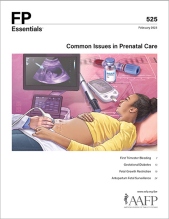
This clinical content conforms to AAFP criteria for CME.
Patients at increased risk of stillbirth should be assessed with antepartum fetal surveillance (AFS) tests at regular intervals. In general, AFS should begin at the gestational age at which delivery would be considered. Most surveillance tests are performed weekly, but more frequent testing should be considered for patients with high-risk conditions. AFS tests include fetal movement monitoring, nonstress test, contraction stress test, biophysical profile, and modified biophysical profile. Umbilical artery Doppler velocimetry is used in the setting of fetal growth restriction. Abnormal test results should prompt additional assessment and consideration of delivery. Normal test results can provide reassurance about fetal well-being, but cannot predict the likelihood of acute incidents, such as placental abruption and umbilical cord infarction.
Case 1, cont’d. At a visit for antepartum fetal surveillance tests, Sylvia tells you that her friend with gestational diabetes undergoes ultrasound twice per week. She also says she has a cousin who experienced a stillbirth and she is worried. Given her risk factors, including obesity, advanced maternal age, gestational diabetes managed with insulin, and fetal growth restriction, she asks if she should be undergoing more tests.
Background
Antepartum fetal surveillance (AFS) refers to evidence-based methods used to identify viable fetuses at risk of stillbirth before natural or induction of labor.88 This effort must be balanced against iatrogenic prematurity, which is the result if a fetus identified as at risk is delivered early based on the results of abnormal test results.
Subscribe
From $350- Immediate, unlimited access to FP Essentials content
- 60 CME credits/year
- AAFP app access
- Print delivery available
Edition Access
$44- Immediate, unlimited access to this edition's content
- 5 CME credits
- AAFP app access
- Print delivery available
